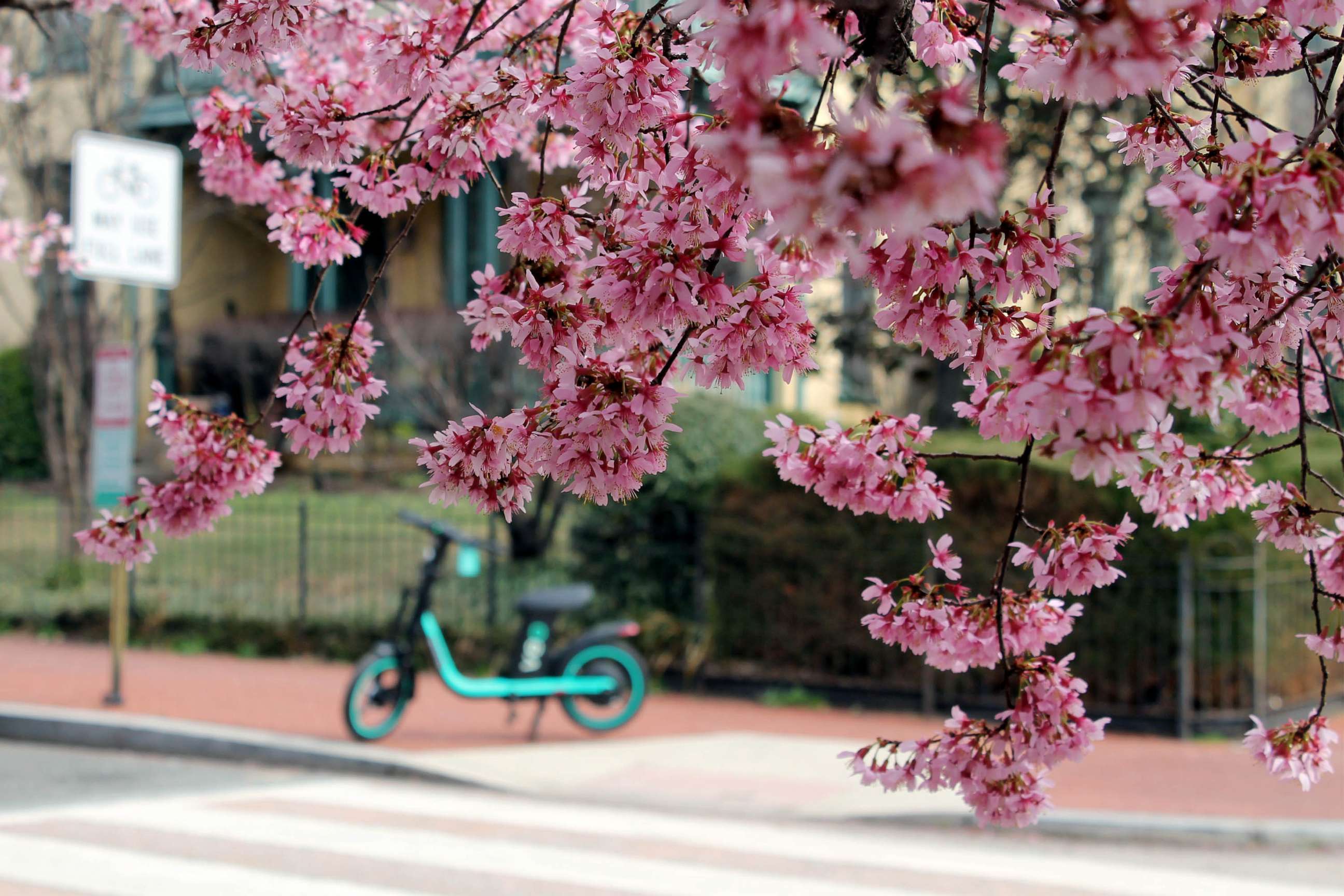Washington, D.C.'s cherry blossoms might make an early appearance, as mild winter kicks in
Several cherry blossoms around the city have already bloomed in February.
Springtime has come early to Washington D.C., if the city's cherry blossom trees have anything to say about it.
Across the Potomac, dozens of trees have already started to bloom creating an odd scene of pink flowery streets and parks just mere weeks after Groundhog Day.
While park officials and longtime city observers have said that while it's too early to know when the city's most famous cherry blossoms will be blooming around the National Mall, they said it's likely to be a much earlier than usual bloom.
"I don't think anybody has been surprised, it's been an extremely mild winter," Mike Litterst, a spokesman for the National Parks Service told ABC News. "Heat drives them to bloom. In the absence of cold...we can't be surprised that we're having an earlier bloom."

Although the likely later bloom will affect vacations, parties and other events surrounding the peak bloom on the Tidal Basin, event organizers told ABC News they will plan accordingly and still have fun things to do even if the petals are gone in April. At the same time, those who care for the trees warn that this phenomenon is a warning about the dangers of climate change to flora.
The 3,700 Tidal Basin cherry blossom trees, most of which have been around since they were brought to the city in 1912, are mostly made up of Yoshino Cherry, which bloom later than other cherry blossom trees in the city, according to Litterst.
The timing of the budding process for the Yoshino trees around the basin has varied over the years, but it has typically started the green bud stage, which is the first stage, around the end of February or the beginning of March, the NPS said. Peak bloom typically occurs from the end of March to early April, according to NPS data.
This year's Yoshino green bud stage took place around Feb. 23, the earliest recorded green bud stage in nearly 20 years, NPS data showed. The earliest full bloom took place on March 15, 1990, according to the agency.

Litterst said the NPS will announce the forecasted date for full bloom on March 1, but warned that drastic weather patterns, like an arctic cold front similar to the one that brought late frost and damaged the trees in 2017, could affect the timeline.
"It's likely to be earlier than the average dates," he noted.
Julie Moore, a spokeswoman for the Trust for the National Mall, the non-profit group that helps maintain and restore the greenspace, told ABC News that climate change is the major factor behind this year's early bloom.
This winter has seen abnormally warmer temperatures in Washington D.C., according to the National Weather Service, as January's average temperatures were 45.2 degrees Fahrenheit, nearly eight degrees higher than the normal temperatures for that month.

That mild winter has so far continued into February for several days with temperatures for Thursday forecasted to be in the 80s, according to the forecast.
Moore said the trust's arborists have seen the full bloom dates vary over the years due to shifts in extreme cold and milder winters.
"There are always a lot of twists and turns so we simply don't know which way it will land," Moore told ABC News.
Moore reassured that even if peak bloom takes place before spring officially begins, people who are looking to view the flowers won't have to rush their plans as the petals will still be visible a few weeks after full bloom.
For the events tied to the cherry blossoms, such as the National Cherry Blossom Festival, a possible early bloom will shift some planning and timing, but it won't necessarily mean that people who come to the city in April to celebrate spring will be left out, according to organizers.

Diana Mayhew, the president and CEO of the National Cherry Blossom Festival, told ABC News her team is eagerly awaiting the March 1 announcement and will be making changes to its schedule of events, which are tentatively set for March 20 through April 14, based on the full bloom.
"We have a contingencies place of moving 100 performances over the period," Mayhew told ABC News.
She added that many events that have been tentatively scheduled for the nearly month-long festival will likely stay in place as the celebration's themes have expanded to include celebrating the arrival of spring.
"The good thing is that a lot of people are within driving distance, so our visitors will come when the blossoms bloom and they come back," Mayhew said.
Litterst said it is too early to tell what kind of short-term effects an early bloom will have on the trees this season, but said that higher temperatures will have an impact.
"Over time, we're talking about the next 100 years, warming trends and climate change could have an effect on pollinators," he said.

Moore said that other effects of climate change, including flooding on the Tidal Basin have also been damaging the trees over the years. Last year, the Trust had to replenish some saplings, according to Moore.
"The cherry blossom trees are in jeopardy," she said.
Moore noted that several parties are working to come up with solutions.
In 2019, NPS, the Trust for the National Mall and the National Trust for Historic Preservation partnered with landscape architectural firms to create the Tidal Basin Ideas lab, a non-profit that is working on improving and bolstering the landscape to withstand environmental changes.
Some of the ideas that have been floated by the group include redesigned pedestrian paths, levees and new ground construction that would absorb the water.
"We need to make sure they continue to bloom for the next generation," Moore said.




